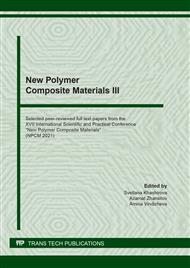p.98
p.104
p.110
p.119
p.125
p.132
p.137
p.144
p.150
The Influence of Technological Parameters on Morphology of Electrospun Nanofibers Based on Hyaluronic Acid
Abstract:
Electrospinning as a high-functioning, multi-operated, and advanced method of nanofiber production allowing to obtain fibrous materials based on different polymers for a wide range of biomedical and bioengineering applications. Hyaluronic acid is one of the most promising polymers for nanofiber formation due to its unique biological and biochemical properties. In spite of the difficulties and special features of the electrospinning from hyaluronic acid solutions, the amount of studies in this field is ever-growing. Unfortunately, there is a significant shortage of fundamental data describing the relations between the technological parameters and the nanofiber morphology. This study considers the key technological parameters of the electrospinning process such as applied voltage and flow volume rate and evaluates their influence on the morphology, mean diameter, and diameter distribution width of nanofibers based on native hyaluronic acid. The optimal range of the defined parameters has been established, at which the stability of the fiber formation is ensured. It is shown that by varying of the applied voltage and the flow volume rate of the polymer spinning solution, it is possible to control the properties of nanofibers.
Info:
Periodical:
Pages:
125-131
Citation:
Online since:
September 2021
Price:
Сopyright:
© 2021 Trans Tech Publications Ltd. All Rights Reserved
Share:
Citation:


